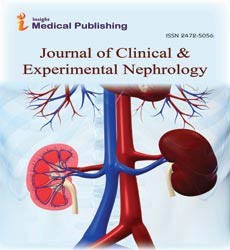A Short Note on Glomerulonephritis
Andria Archer
Andria Archer*
Division of Nephrology, Stellenbosch University, Cape Town, South Africa
- *Corresponding Author:
- Andria Archer
Division of Nephrology,
Stellenbosch University,
Cape Town,
South Africa,
E-mail: And@sun.ac.za
Received Date: December 6, 2021;Accepted Date: December 20, 2021;Published Date: December 27, 2021
Citation: Archer A (2021) A Short Note on Glomerulonephritis. J Clin Exp Nephrol Vol.6 No.6: 121.
About the Study
Glomerulonephritis (GN) is a term used to describe a category of kidney diseases (usually affecting both kidneys). The name stems from the fact that many diseases in the kidneys are characterised by inflammation of the glomeruli or small blood vessels, but not all diseases are inflammatory. Because it is not a single disease, it might present as isolated hematuria and/or proteinuria (blood or protein in the urine) or as a nephrotic syndrome, acute kidney damage, or chronic kidney disease. They are classed as either non- proliferative or proliferative and are separated into several pathologic patterns. Because the outcome and treatment differ based on the kind of GN, it is necessary to diagnose the pattern of GN.
Edema is a symptom of the nephrotic syndrome, which is defined as increased protein in the urine and decreased protein in the blood, as well as increased fat in the blood. Protein permeability is increased when the podocytes that surround the glomerulus become inflamed, resulting in an increase in ejected proteins. When the number of proteins excreted in the urine exceeds the liver's ability to compensate, the blood contains less proteins, particularly albumin, which accounts for the majority of circulating proteins. As the number of proteins in the blood diminishes, the oncotic pressure of the blood drops.
Edoema develops when the oncotic pressure in the tissue remains constant. Although decreasing intravascular oncotic (osmotic) pressure helps patients with edoema, recent research has found that significant salt retention in the distal nephron (collection duct) is the primary source of water retention and edoema in the nephrotic syndrome. This is compounded by the adrenal gland's release of the hormone aldosterone, which promotes sodium and water retention and is released in response to a drop in blood pressure. The increased activity of the liver is thought to be the cause of hyperlipidemia.
The nephritic syndrome is defined by blood in the urine (especially red blood cell casts with dysmorphic red blood cells) and a decrease in urine volume in the context of hypertension. The epithelial barrier is thought to be broken due to inflammation of the cells lining the glomerulus, resulting in blood in the urine in this sickness. Simultaneously, reactive changes such as mesangial cell growth may cause a reduction in kidney blood flow, resulting in a reduction in urine production. The renin–angiotensin system may be triggered as a result of reduced perfusion of the juxtaglomerular apparatus, leading in hypertension.
Minimal change disease is a type of nephrotic syndrome that occurs without visible glomerular abnormalities on microscopy. The most common cause of nephrotic syndrome in children is minimal change disease, which is characterised by edoema, an increase in proteins released from urine, a decline in blood protein levels, and a rise in circulating lipids (nephrotic syndrome). Electron microscopy within the glomeruli may indicate a fusion of the podocytes foot processes, even if optical imaging shows no changes (cells lining the basement membrane of the capillaries of glomerulus). It is routinely treated with corticosteroids, and it does not result in chronic kidney impairment.
Focal segmental glomerulosclerosis is defined by the sclerosis of segments of some glomeruli. The most common symptom is nephrotic syndrome. HIV or heroin use can cause this kind of glomerulonephritis, or it can be inherited as Alport syndrome. There is no recognised reason for 20-30% of focal-segmental glomerulosclerosis. On microscopy, afflicted glomeruli show an increase in hyalin, a pink and homogeneous material, fat cells, an increase in the mesangial matrix, and collagen. Although corticosteroids can help with focal segmental glomerulonephritis, up to half of those who have it experience progressive kidney function loss, eventually leading to renal failure.
Open Access Journals
- Aquaculture & Veterinary Science
- Chemistry & Chemical Sciences
- Clinical Sciences
- Engineering
- General Science
- Genetics & Molecular Biology
- Health Care & Nursing
- Immunology & Microbiology
- Materials Science
- Mathematics & Physics
- Medical Sciences
- Neurology & Psychiatry
- Oncology & Cancer Science
- Pharmaceutical Sciences
